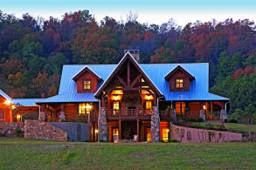
Should I ask for specifics on sealing the air penetration places throughout a house, such as windows, doors, attics, crawl spaces, where the roof meets the floor and unfinished basements? What do I need to know?
A universal truth of construction is that anytime you remove a portion of a wall, whether it's a window or a door, you create the opportunity for air infiltration. The same applies where the log walls stop and other structural components, like foundations and roofs, start. All of these joints and openings must be properly connected and completely sealed to create a tight envelope.
While you're evaluating builders for your log home, it's a good idea to ask them how they address these important points of construction. But how do you know if the answers they provide are good ones? Let's use window sealing, as a specific example.
In a full-log home, settlement has to be taken into account. When windows are set, the installer typically does a good job of inserting the window into the buck (the casing that the widnow attaches to, which then is attached to the log walls, allowing the window to stay in a static location as the logs move). It's the area between the buck and the logs where the air could leak through, because that's where the builder intentionally leaves room for settling. But there are techniques to properly insulate and seal this space so you can have an air-tight log home and still accomodate for movement.
For example, after the logs are cut and before the bucks are inserted, your builder should ensure that the window openings have straight, linear cuts. If they aren't even, you open yourself up to issues. If one log is even as little as 1/4-inch shorter than the one above or below it, there will be a gap. As the logs settle, the gap could allow air to penetrate.
Next, it's critical that before the windows/bucks are installed per your manufacturer's system, the builder inserts a compressible foam sealant called a "sill seal" into the cavity. Once the buck is nailed into the logs, the sill seal fills the gaps; but because it's not adhesive, it allows the logs to slide and settle properly.
Then, when the windows are completely in place, the entire buck should be sealed with a bead of caulk, which will then be swathed in window tape, which will be concealed by decorative trim, inside and out. At this point, the window is sealed and, if done properly, will be about 98 percent effective at eliminating unwanted air infiltration or escape. (Of course, the quality of the window you choose will also play a key role in its energy effectiveness.)
Likewise, it's essential to have tight connections where the first course of logs attaches to the foundation material and the last course affixes to the roof. Not to mention that to recap the most benefits from energy-efficient construction, you shouldn't forget about insulation. There are a variety of ways to insulate your log home's non-log cavities, like an attic. Everyone is familiar with fiberglass batt insulation, but that's not your only (or most effective) option. Blow-in cellulose has nearly triple the efficiency of batt insulation and structural insulated panels (a solid-foam core sanwiched between two layers of oriented strand board), which are probably the most energy efficient option of all, are becoming a more popular choice. When it comes to basements, insulated concrete forms )ICFs) will provide better insulation than standard poured concrete or masonry blocks.
The best you can do is ask your builder as many questions as needed to feel comfortable that he/she is knowledgeable. The more questions you ask, the more you builder will recoginze that energy efficiency is important to you.
Published on: February 8th, 2018
Like what you read? Need more information? Achieving energy efficiency for you log homes goes beyond the logs. We've asked industry experts, Katahdin Cedar Log Homes to help with the answers. Click here to see more.
Like what you read? Need more information? Achieving energy efficiency for you log homes goes beyond the logs. We've asked industry experts, Katahdin Cedar Log Homes to help with the answers. Click here to see more.











